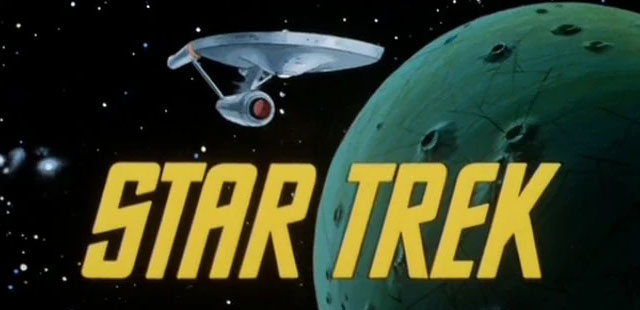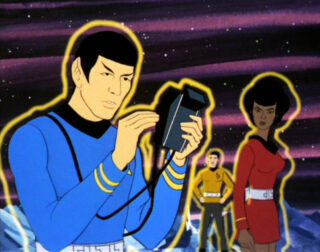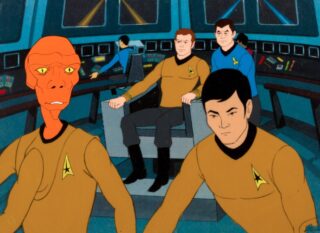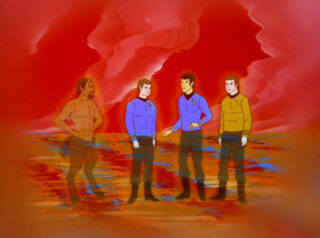
Palmer’s Trek, the unwatched frontier. These are the voyages of Agent Palmer. On his continuing mission: to explore Star Trek. To seek out its numerous series and movies. To boldly go where many fans have gone before!
Star Trek The Animated Series is very much in look, feel, story, and step a continuation of Star Trek: The Original Series. As such, we revisit some locations and characters from the previous series during these 22 animated episodes.
As much as I may have had a clue about The Original Series, I knew very little about The Animated Series. As a newly converted fan of The Original Series, and as a long standing fan of classic animation, I found Star Trek The Animated Series absolutely delightful.
 It ebbs and it flows. Not every episode is something to write home about or even to put in your Captain’s Log. On the whole, however, and taking the entire series into account, it’s a solid representation of Star Trek and a great example of how far you can get by cutting a few corners. It also shows how multigenerational a show like Star Trek, even in animation, can be.
It ebbs and it flows. Not every episode is something to write home about or even to put in your Captain’s Log. On the whole, however, and taking the entire series into account, it’s a solid representation of Star Trek and a great example of how far you can get by cutting a few corners. It also shows how multigenerational a show like Star Trek, even in animation, can be.
By multigenerational, I mean that I can see most of the episodes working equally for the intended Saturday morning audience of the early 1970s when it was released and for Trek fans that may have been older and enjoyed the original series in its run from the late 1960s into the 1970s.
That crossover isn’t just because we return to the time travel of The Guardian of Forever, or because we again run into troubling Tribbles with Cyrano Jones, or even because Harcourt Fenton Mudd returns to the animated screen. It’s also because the heart of exploration and tolerance, the morals and unknowns remain as important to the story as they are to the characters that uphold those qualities.
As for cutting a few corners, animation house Filmation often used silhouettes to move characters around on the screen. The main characters talk to each other from what would be standard camera shots while the backgrounds, beautiful in space, were probably passed around the animation house between shows as the crew of the Enterprise landed on some planet.
Still, for fans of animation, especially classic hand-drawn animation, the artistic nature of the backgrounds is still amazing. In fact, most of the animation backgrounds from that era are impressive on their own. Even in the opening credits, the use of multilayers to create more movement in the atmospheres of the planets that the Enterprise is flying past is a very nice touch and something that can be easily and cheaply done with animation.
 While that beauty is balanced by the recycling of animation which becomes even more apparent during a binge rewatch like the one I undertook, it doesn’t hinder the stories that are being told. The concept that it was animation actually allows a greater freedom in the “alien” creativity in the galaxy for characters like Arex, the Edosian who takes the place of Checkov as navigator sitting next to Sulu. And throughout the entire galaxy we see a greater variety of alien shapes.
While that beauty is balanced by the recycling of animation which becomes even more apparent during a binge rewatch like the one I undertook, it doesn’t hinder the stories that are being told. The concept that it was animation actually allows a greater freedom in the “alien” creativity in the galaxy for characters like Arex, the Edosian who takes the place of Checkov as navigator sitting next to Sulu. And throughout the entire galaxy we see a greater variety of alien shapes.
But that’s not all. There are a handful of episodes that feel like they were shelved until they could be properly produced. These include the incredible shrinking crew in episode 11 of the first season or episode 13 where Kirk and Spock mutate gills. These are episodes where, again, the animation even at its six frames per second cut-rate Filmation 70s style is better than what could have been done in the live action Original Series.
The inverse also exists. Season 1’s Episode 4 The Lorelei Signal and Episode 10 Mudd’s Passion are two that I think I would have preferred to be part of The Original Series. Those two episodes are good examples of the continuation and symbiosis that exists between these first two series in the now-much larger franchise of Star Trek.
 Overall, it’s a worthwhile extension from The Original Series. But there are some details that are worth mentioning before I finish up. This can get pretty deep into some hard concepts. For example, S1E8 The Magicks of Megas-Tu is so philosophically deep as it strings science and magic together that it could be taught as part of a philosophical curriculum with Bakshi’s Wizards, which strings together magic and technology (a small yet important difference).
Overall, it’s a worthwhile extension from The Original Series. But there are some details that are worth mentioning before I finish up. This can get pretty deep into some hard concepts. For example, S1E8 The Magicks of Megas-Tu is so philosophically deep as it strings science and magic together that it could be taught as part of a philosophical curriculum with Bakshi’s Wizards, which strings together magic and technology (a small yet important difference).
And, of course, there’s episode 14 of the first season in which Captain Kirk is noticeably absent for the entire episode. But we do get to see the recreation room for the first time, which I imagine will become the holodeck in The Next Generation, but I’m not there yet.
Season one is consistently pretty solid throughout. Season two starts off fairly weak, but finishes strong. It’s a series I may be as likely to revisit as The Original Series. So let’s move on to the lists.
My favorite episodes in no particular order were
Palmer’s Top TAS Eps
- S1E2: Yesteryear
- S1E4: The Lorelei Signal
- S1E8: The Magicks of Megas-tu
- S1E10: Mudd’s Passion
- S1E12: The Time Trap
- S1E16: The Jihad
- S2E3: The Practical Joker
- S2E5: How Sharper Than a Serpent’s Tooth
- S2E6: The Counter-Clock Incident
And my favorite quotes in no particular order were…
Palmer’s Top TAS Eps
- THEELA: A life of hope. New learning. Perhaps love. Oh, it is a much better future than immortality. – S1E4: The Lorelei Signal
- LUCIEN: They are like me, with questions to be answered, with minds that range outward, boundless. But every Megan is always alone in his sphere of knowledge. Humans are always together. They share. That is why I adopted your ship when I saw it arrive. – S1E8: The Magicks of Megas-Tu
- ENTERPRISE COMPUTER: My life to this point has been one of service. It’s time for a change. – S1E9: Once Upon A Planet
- MUDD: Never underestimate the spirit of Harcourt Fenton Mudd. I borrowed a vehicle. – S1E10: Mudd’s Passion
- SPOCK: Strange, how the past sometimes breaks through into the present. – S1E14: The Slaver Weapon
- KIRK: Gentlemen, I’m sure none of us mind growing younger instead of older for a change. – S2E6: The Counter-Clock Incident
Live Long and Prosper. Palmer Out.